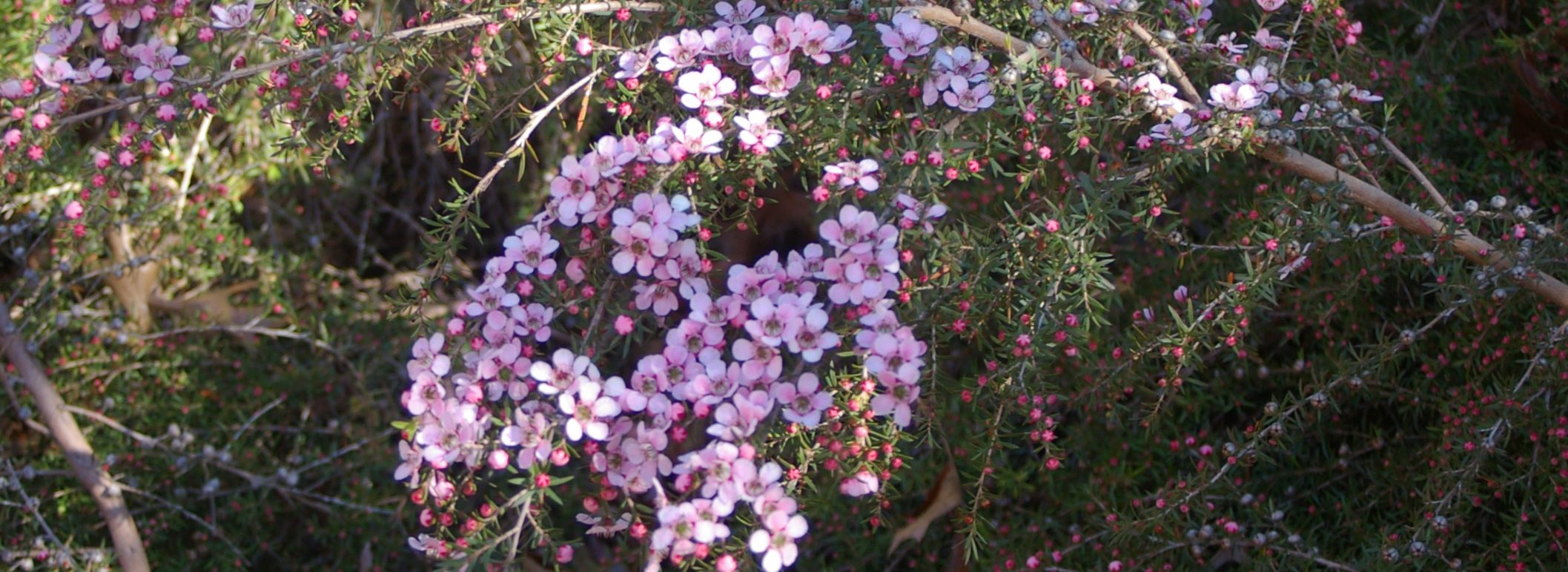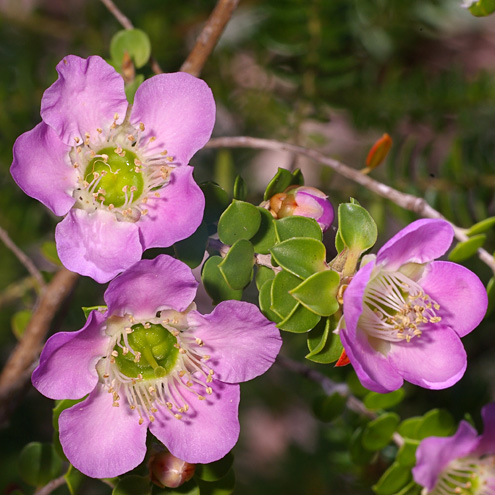(For Plant Profiles on selected species and cultivars of Callistemon and Melaleuca, go to Callistemon and Melaleuca in the ‘Common Genera and Families’ section of the website)
Leptospermum & Relatives – Background
Introduction
Species in the genus Leptospermum are commonly known as tea trees and they are probably some of the best known of all Australian native plants. Tea trees are members of the widespread myrtle family of plants (Myrtaceae) and within this family there are a number of genera which are regarded as having a close relationship with Leptospermum. The genera in this related group are known as the Leptospermum Alliance of the subfamily Leptospermoideae. Some of these related genera are also very well known, such as Callistemon (bottlebrushes) and Melaleuca (paperbarks and honey myrtles), and the Leptospermum alliance also includes some less well known genera such as Kunzea, Calothamnus, Beaufortia and Eremaea.
In the traditional characterisation of the myrtle family, there are about seven groupings or alliances within the subfamily Leptospermoideae. These include the Eucalyptus alliance and the Chamelaucium alliance. The former includes Angophora, Corymbia and Eucalyptus while the latter includes genera such as Chamelaucium (eg. Geraldton wax), Darwinia, Verticordia and Baeckea.
All members of the subfamily Leptospermoideae are characterised by having a dry fruit. In the Leptospermum alliance, the fruit consists of 3 or more cells each of which contain several (sometimes many) ovules, the unfertilized seed. The fruit is dehiscent (ie. the fruits open to release the seed, although this sometimes does not occur until the plant dies or the fruit is physically removed from the plant).
Potential Name Changes
In recent years the traditional relationships within the myrtle family have been challenged and the somewhat neat arrangement of subfamilies and alliances within the family is now regarded as difficult to justify (see ‘Myrtaceae revisited: a reassessment of infrafamilial groups‘ under the “Further Information” tab for a technical discussion of the situation).
Callistemon and Melaleuca
Traditionally, these two genera have been separated on the basis of the arrangement of the stamens. In Callistemon each stamen joins the floral tube independently of every other stamen (this is referred to as the stamens being “free”). In Melaleuca, on the other hand, the stamens are joined together into groups with each group joining the floral tube as a unit (this is referred to as the stamens being “united”). This can more easily understood by reference to the diagrams in the article under the tab titled “Melaleuca and Callistemon” on the Callistemon page.
The problem with the classification of Callistemon and Melaleuca on the basis of the arrangement of the stamens is that this supposed difference is not clear cut – Callistemon tends to merge into Melaleuca rather than being unambiguously distinct.
Over the years there have been suggestions that the differences between species of the two genera are not sufficient to warrant them being kept distinct. A paper by Lyn Craven of the Australian National Herbarium (Novon 16 468-475; December 2006 “New Combinations in Melaleuca for Australian Species of Callistemon (Myrtaceae)”) argues that the differences between the two genera are insufficient to warrant them being retained separately and that they should be combined. As Melaleuca has precedence, adoption of Craven’s work would transfer all species of Callistemon into Melaleuca but at this stage the re-classification has not been taken up in the Australian Plant Census which ANPSA accepts as the authority on plant taxonomy. The possibilitity remains that Callistemon will eventually be subsumed into Melaleuca.
Because these two genera are so well known and widely cultivated, separate sections of this web site have been developed to cater for each of them – see our profiles of Callistemon and Melaleuca.
Potential Changes in Leptospermum
A revision of the genus Leptospermum was published in August 2023 (Wilson, Peter G. & Heslewood, M.M. (3 May 2023), Revised taxonomy of the tribe Leptospermeae (Myrtaceae) based on morphological and DNA data. Taxon 72(3).
The publication transferred many species of Leptospermum into three new genera – Apectospermum, Aggreflorum, Gaudium and revived a fourth, Leptospermopsis. This re-classification reduced the number of species in Leptospermum from about 83 to about 34. Although this revision has been taken up by some state herbaria, it has not yet been accepted in the Australian Plant Census. For this reason ANPSA has retained Leptospermum as the accepted name for the time being.
Members of the Leptospermum Alliance
Despite the potential for changes in the taxonomy, the plants within the traditional view of the Leptospermum alliance do form a consistent and recognisable grouping. For this reason , and for simplicity and convenience, the term “Leptospermum alliance” will be used here.
The accompanying table lists the genera in the alliance as well as the number of species in each genus and the distribution of each genus by state. The list is based mainly on information from the Australian Plant Name Index, supplemented by information from the Western Australian Florabase data for Paragonis and Taxandria, recent classifications in that state for some species previously classified under Agonis. Some members of the Alliance are also found outside of Australia.
Genera in the Leptospermum Alliance
|
Genus
|
No.of
Species* |
Distribution
|
|---|---|---|
|
Agonis
|
|
WA
|
|
Angasomyrtus
|
|
WA
|
|
Asteromyrtus
|
|
WA, NT, Qld & Papua New Guinea
|
|
Beaufortia
|
|
WA
|
|
Callistemon
|
|
All states & New Caledonia
|
|
Calothamnus
|
|
WA
|
|
Conothamnus
|
|
WA
|
|
Eremaea
|
|
WA
|
|
Homalospermum
|
|
WA
|
|
Kunzea
|
|
All states
|
|
Lamarchea
|
|
WA, NT
|
|
Leptospermum
|
|
All states & south-east Asia
|
|
Melaleuca
|
|
All states & south-east Asia
|
|
Neofabricia
|
|
Qld
|
|
Paragonis
|
|
WA
|
|
Pericalymma
|
|
WA
|
|
Phymatocarpus
|
|
WA
|
|
Regelia
|
|
WA, NT
|
|
Taxandria
|
|
WA
|
| * Approximate number only; some genera contain numerous unnamed species and other genera are in need of botanical revision. Furthermore, within Agonis, some recent classifications have not yet been accepted by all authorities.. | ||
Characteristics of Leptospermum and its Relatives
Plants in the Leptospermum alliance vary in habit from small, sometimes prostrate shrubs to medium sized trees. Like other members of the myrtle family, the leaves contain aromatic oils which can be smelled by crushing the leaves between the fingers. In some cases the aroma can be citrus-like, as in Leptospermum petersonii. The flowers are superficially quite variable. All have five-petalled flowers but in some (eg. Callistemon and Melaleuca) the petals are small or deciduous and the stamens form the conspicuous parts of the flowers. In others (eg. Leptospermum and Agonis) the petals are the most conspicuous feature. In others again (eg Kunzea) some species have conspicuous petals (eg. K.baxteri) and others have conspicuous stamens (eg. K.affinis) – botany was never easy!
Many of the plants in the Leptospermum alliance have flowers that produce large amounts of nectar. These include Callistemon, Melaleuca, Beaufortia and Regelia. These tend to be pollinated mainly by birds, including honeyeaters and lorikeets. Insects appear to be the main pollination vectors for other members of the alliance such as Leptospermum, Agonis and Neofabrica. Kunzea, is an interesting genus in that it has some species that are mainly bird pollinated and others that are insect pollinated.
The majority of species in this group of plants are found in heath, woodland or open forest of mainly temperate areas. They are absent in rainforest and arid areas although many species do occur in the tropics.
The following table lists some of the general features of each genus. The table is not intended to be a botanical ‘key’ as differences between the genera may not always be apparent to the casual observer, requiring botanical knowledge and a high magnification viewer.
Some Characteristics of Leptospermum and its Relatives
|
Genus
|
Characteristics
|
|---|---|
|
Agonis
|
Medium shrubs to medium trees; flowers “tea tree-like” with petals that tend to remain attached to the floral tube for some time after flowering is finished.
|
|
Angasomyrtus
|
Monotypic genus (Angasomyrtus salina). Small to medium shrub with characteristics similar to Leptospermum but it has opposite foliage (alternate in Leptospermum). It is also similar to Kunzea but has stamens that are shorter than the petals.
|
|
Asteromyrtus
|
Medium shrubs to medium trees with flowers in clusters similar to Melaleuca, one difference being that the seeds are ‘winged’ in Asteromyrtus.
|
|
Beaufortia
|
Small to medium shrubs with flowers in clusters similar to Melaleuca, a distinguishing feature being that the anthers are basifixed in Beaufortia. It is closely related to Calothamnus, Eremaea, Phymatocarpus and Regelia) but differs in the structure of the anthers. Flowers may be grouped in ‘bottlebrush’ or globular clusters.
|
|
Callistemon
|
Small and medium shrubs to medium trees with flowers grouped in ‘bottlebrush’ clusters. It differs from Melaleuca in having stamens that are free (but see discussion above).
|
|
Calothamnus
|
Small to medium shrubs with flowers in clusters similar to Melaleuca, a distinguishing feature being that the anthers are basifixed in Calothamnus. It is closely related to Beaufortia, Eremaea, Phymatocarpus and Regelia) but differs in the structure of the anthers. Flowers grouped in one-sided ‘bottlebrush’ clusters
|
|
Conothamnus
|
Small shrubs with flowers in clusters similar to Melaleuca, The main difference being that the 3-celled ovary contains only one ovule in Conothamnus.
|
|
Eremaea
|
Small to medium shrubs with flowers in clusters similar to Melaleuca, a distinguishing feature being that the anthers are basifixed in Eremaea. It is closely related to Beaufortia, Calothamnus, Phymatocarpus and Regelia) but differs in the structure of the anthers. Flowers tend to be grouped in cone-shaped clusters.
|
|
Homalospermum
|
Monotypic genus (Homalospermum firmum). Medium shrub to about 2.5 metres high with flowers that are “tea tree-like”. Closely related to Pericalymma but differing in the structure of the ovary.
|
|
Kunzea
|
Small to large shrubs which have flowering characteristics between Callistemon and Leptospermum (ie. some have “tea tree-like” flowers with prominent stamens while others tend to have flowers in ‘bottlebrush’ clusters.
|
|
Lamarchea
|
Small and medium shrubs to small trees with flowers that are superficially similar to Calothamnus but which occur singly rather than in clusters. However, Lamarchea is more closely related to Melaleuca based in the characteristics of the anthers.
|
|
Leptospermum
|
Small and medium shrubs to small trees having flowers with petals that may be deciduous or persistent. The stamens occur in a single row around the floral tube (a difference to Neofabricia) and they are shorter than the petals (a difference to Kunzea). The leaves are alternate (a difference to Angasomyrtus.
|
|
Melaleuca
|
Small and medium shrubs to large trees with flowers usually grouped in either ‘bottlebrush’ or globular clusters. It differs from Callistemon in having stamens that are united (but see discussion above). It differers from Beaufortia, Calothamnus, Eremaea, Phymatocarpus and Regelia in the characteristics of the anthers and from Conothamnus in the structure of the ovary.
|
|
Neofabricia
|
Small to medium shrubs and small trees similar to Leptospermum but having stamens in arranged in several rows.
|
|
Paragonis
|
Small to medium shrubs previously included in Agonis and similar to that genus.
|
|
Pericalymma
|
Small to medium shrubs with flowers that are “tea tree-like”. Closely related to Homalospermum but differing in the structure of the ovary.
|
|
Phymatocarpus
|
Small to medium shrubs with flowers in clusters similar to Melaleuca, a distinguishing feature being that the anthers are basifixed in Phymatocarpus. It is closely related to Beaufortia, Calothamnus, Eremaea and Regelia) but differs in the structure of the anthers. Flowers are grouped in globular clusters.
|
|
Regelia
|
Small to medium shrubs with flowers in clusters similar to Melaleuca, a distinguishing feature being that the anthers are basifixed in Regelia. It is closely related to Beaufortia, Calothamnus, Eremaea and Phymatocarpus) but differs in the structure of the anthers. Flowers are grouped in globular clusters.
|
|
Taxandria
|
Small to medium shrubs previously included in Agonis and similar to that genus.
|
Leptospermum & Relatives – Propagation
Introduction
Plants in the Leptospermum Alliance are propagated by both seed and cuttings, the best method for a particular species being determined through experience. Grafting may be a possibility for those species that have proven to be difficult in cultivation.
Seed
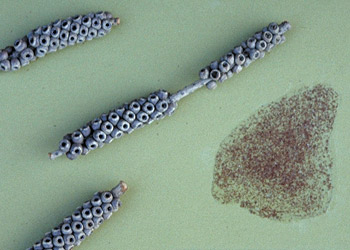 |
| Members of the Leptospermum Alliance have very fine seed Photo: Brian Walters |
Seed of the plants in the Leptospermum Alliance is either retained within the mature fruits until the plant dies or is released from the fruits annually. Whether seed is retained or released is mainly determined by environmental issues – plants native to areas frequented by bushfires usually retain the seed on the plant.
In the case of species which retain the seed indefinitely on the plant, the capsules need to collected and placed in an open container in a warm position until the fine seed is released. This should occur in 2-7 days. For best results, the capsules should be at least 12 months old (ie. the most recently formed capsules are best avoided as the seed may not be fully developed). With those species which release the ripe seed annually, the plant needs to be kept under observation and seed capsules collected when the capsules commence to open.
In some cases (eg. Beaufortia), seed may not be released even after the mature capsules have been removed from the plant. In such cases it has been found that grinding the capsules for a few seconds in a coffee grinder (and then sowing the debris) is an effective treatment method.

Seed usually germinates well by conventional sowing methods in seed raising mixes although seedlings may be subject to “damping off”. To minimize this possibility, keep seeds moist but not wet. Germination should occur in 14 to 30 days, depending on the species.
A common method used for germination of Callistemon and related plants is the “bog method” where the pot containing the seeds is placed into a saucer of water until germination occurs. This results in moisture reaching the seeds by capillary action and ensures that the seeds do not dry out.
Cuttings
Propagation of members of the Leptospermum Alliance from cuttings is generally a reliable method. Cuttings about 75-100 mm in length with the leaves carefully removed from the lower half to two-thirds seem to be satisfactory. “Wounding” the lower stem by removing a sliver of bark and treating with a “root promoting” hormone both seem to improve the success rate.
Grafting
Species native to one area of Australia may not thrive when grown in another area (this, of course, is not unique to this group of plants and is a factor to be considered with most Australian native plants). Because of this, some experimentation has been done, mainly by amateur growers, on grafting difficult species onto hardy root stocks, however, little data is available on successful scion/stock combination.
The following table lists suggested stock plants that could be considered for some of the difficult to grow species. The species selected as a stock should, of course, be a reliable grower in the district when the grafted plant is to be grown.
| Scion | Potential Stock Plant |
| Beaufortia | Calothamnus, Melaleuca |
| Eremaea | Calothamnus, Melaleuca |
| Western Kunzea | Eastern Kunzea |
| Western Melaleuca | Eastern Melaleuca |
| Phymatocarpus | Calothamnus, Melaleuca |
| Regelia | Calothamnus, Melaleuca |
General Propagation
Further details on general plant propagation can be found at the Society’s Plant Propagation Pages.
Leptospermum & Relatives – Cultivation
With such a large and diverse group of plants which inhabit most climatic niches, it is not possible to give more than a brief and fairly superficial guide to some of the more commonly seen genera and species. The wide distribution of the Leptospermum Alliance also means that problems may be experienced when trying to grow a species in a different climate to that of its natural habitat. As a general guide:
- Species native to south western Australia when dry summers and wet winters are experienced may prove unreliable in tropical and sub tropical areas and temperate areas of wet, humid summers.
- Tropical species may be difficult to maintain in cold districts.
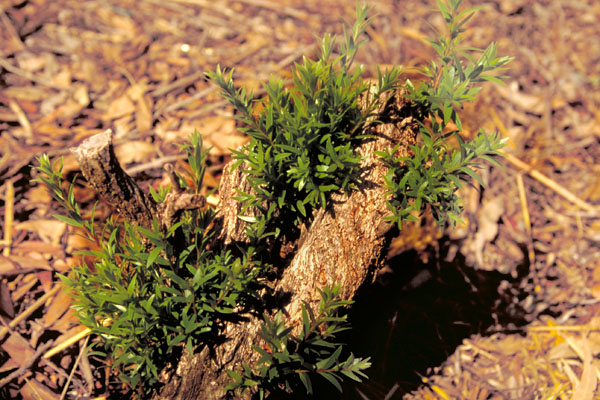 |
| Members of the Leptospermum Alliance usually respond well to severe pruning Photo: Brian Walters |
Despite these cautions, a number of species have proven to be adaptable in seemingly unsuitable climates. For example, the western species M.fulgens, M.nesophila, M.lateritia, M.diosmifolia and M.huegelii are grown very successfully in coastal areas of New South Wales and Queensland while the tropical species M.viridiflora will grow successfully in colder districts if it is protected from frost when young. The two western Callistemon species are also successful in many east coast areas and even spectacular western Kunzea such as K.baxteri and K.pulchella can be grown successfully in the south-east. However, when selecting plants for the garden it is always worth considering the natural distribution of the species and, if in doubt about the suitability of the plant, seek advice from local specialist nurseries.
Some of the plants in the Leptospermum Alliance, particularly Melaleuca and Callistemon, can be found in nature in poorly drained areas. A few, including Melaleuca quinquenervia and M.linariifolia are found in locations where their roots are either permanently or seasonally subject to innundation. As a general rule, however, most plants in this group will perform best in medium to light soils (eg. sandy loam) that are well drained but which retain some moisture. Most require a sunny or lightly shaded position for best flowering.
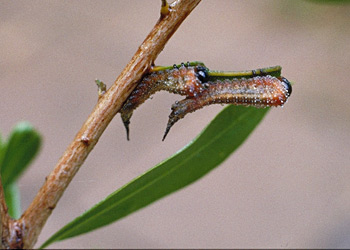 |
| Sawfly larvae on the foliage of Callistemon citrinus Photo: Brian Walters |
Most species respond favourably to a light annual trim to promote bushy growth and the more robust growers will even respond to severe pruning if absolutely necessary. However, pruning those species which have a weeping growth habit can destroy their shape (eg.C.viminalis and its cultivars such as “Hannah Ray” and “Dawson River”).
Species in the Leptospermum Alliance are fairly tolerant of fertilisers, unlike some other genera of Australian plants. The use of a slow release fertiliser after flowering will usually be sufficient.
There are few pests that cause serious problems with this group of plants except that western species may be sensitive to root rot fungus (Phytophora sp.), which is one reason why they can be difficult to grow under humid summer conditions.
Other pests that can be troublesome are:
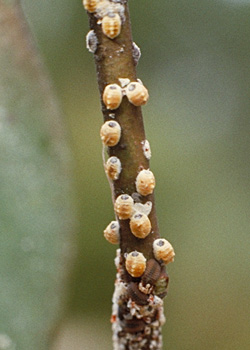 |
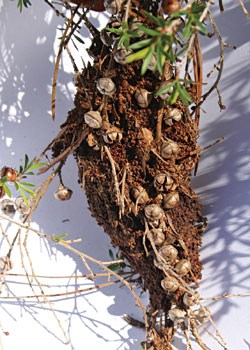 |
|
| Scale Insects (left); Webbing Caterpillar (right) Photos: Brian Walters & Ben Walcott |
||
- Sawfly larvae. These are common pests of Callistemon. They are bronzy green in colour with a pointed tail and, because they occur in groups, they can inflict a great deal of damage to the foliage quickly. They are best controlled by physically removing them either by hand (using gloves!) or with a jet of water from a hose.
- Scale: This can attack a wide variety of native and exotic plants. On smaller plants it can be removed by a strong jet of water but this may need to be carried out several times. If this is not successful, and on larger plants, the traditional treatment with white oil is usually effective.
- Webbing caterpillar. These grubs commonly attack genera such as Melaleuca and Leptospermum but can cause sever damage to certain callistemons (the cultivar C.”Little John” seems particularly prone). The insects cause branches to become bare of leaves and encrusted with a webbing material full of brown dust-like material. Again, a jet of water is effective treatment. The use of general insecticides is possible if effective contact with the caterpillars can be achieved but this is often difficult. Webbing caterpillar attack is most severe with fine leafed species.For further information on webbing caterpillar, see the article Teatree Web Moth (Webbing Caterpillar).
Leptospermum & Relatives – Study Groups
Several study groups fall within the Leptospermum Alliance group of plants. Although these study groups are now closed, their newsletter archives can information can still be accessed via the following links.
***Melaleuca and Allied Genera Study Group***
Leptospermum & Relatives – Further Information
Most books dealing with Australian native plants will contain useful information on the botany and horticulture of Leptospermum and its relatives. There are also a number of useful resources on the internet. Some of the most detailed references are listed below.
Books:
- Cornford, C (1999), “Callistemon, Melaleuca, Kunzea, Leptospermum and Other Genera Within the Myrtaceae Family”, ANPSA Melaleuca and Allied Genera Study Group. A checklist of species and their performance under cultivation in a range of districts.
- Elliot, R and Jones D (1982 to current), “The Encyclopaedia of Australian Plants”, all volumes, Lothian Publishing Company Pty Ltd, Melbourne.
- Holliday, I (1989), “A Field Guide to Melaleucas”, Hamlyn, Australia.
- Holliday, I (1997), “A Field Guide to Melaleucas Volume 2”, Published by I Holliday.
- Holliday, I (2004), “Melaleucas: A Field and Garden Guide”, Reed New Holland, Sydney (see review in the June 2004 issue of Australian Plants online).
- Wrigley, J and Fagg, M (1993), “Bottlebrushes, Paperbarks and Tea Trees”, Angus and Robertson, Australia.
- Young, J.A. (2021), “A Field Guide to Melaleucas of South-West Western Australia”, Jennifer A. Young.
Journals:
- Wilson P.G., O’Brien M, Gadek P.A. and Quinn C.J (2001); “Myrtaceae revisited: a reassessment of infrafamilial groups”, American Journal of Botany, 88:2013-2025.
Several issues of the Society’s journal “Australian Plants” are particularly useful for those interested in Leptospermum and related plants.
- Vol 9, Nos.69 and 70 December 1976 and March 1977; A two-part, detailed description of Callistemon, Melaleuca and related plants including a botanical outline of the features of the Myrtaceae.
- Vol 11, No.89 December 1981; Detailed descriptions of most Callistemon species and many cultivars.
- Vol 14, No.112 September 1987; Myrtles, including Angasomyrtus, Homalospermum and Pericalymma.
- Vol 16, No.125 December 1990; Details of botany of Melaleuca and its relatives, including line drawings and photographs.
- Vol 16, No.127 June 1991; Information on Melaleuca, Calothamnus and Asteromyrtus with photographs.
- Vol 20, No.161 December 1999; The Tea Trees; Leptospermum.
- Vol 21, No.168 September 2001; Information on Melaleuca and related genera; Growing Callistemon in large pots.
- Vol 21, No.171 June 2002; Melaleuca for the garden.
- Vol 22, No.179 June 2004; “Melaleuca psammophila“
- Vol 23, No.182 March 2005; Revision of the Broombush “Melaleuca uncinata Complex”
Internet:
- ANPSA’s Plant Guides for Callistemon and Melaleuca
- A taxonomic revision of Beaufortia (Myrtaceae: Melaleuceae) by A. A. Burbidge; Nuytsia 27: 165-202 (2016)
- Beaufortias in Toowoomba
- Callistemon – Australian National Botanic Gardens.
- Developing Australian Plants for Commercial Horticulture, including Leptospermum.
- Growing Callistemon from Seed
- Growing Native Plants – a series of plant profiles by the Australian National Botanic Gardens; includes a number of species in the Leptospermum Alliance.
- In Praise of Poverty Bush
- Lace Flower; Melaleuca thymifolia
- Leptospermum
- Marvellous Melaleucas
- Melaleucas doing it Tough
- Shrubby Myrtles
- Teatree Web Moth (Webbing Caterpillar)
- Teatree Time
- The Genus Kunzea
- Those Other Myrtaceae
 Australian Native Plants Society (Australia)
Australian Native Plants Society (Australia)